Welcome to another Saturday crossed off towards our approach to the festive season. Now if your club is having a Christmas event, dont forget to tell us. We know that many of you are still a bit unwilling to embrace such things, and with good reason, but getting together will raise your spirits and lift your hearts, and who says you need to be within two metres of each other to have a good time. So if you get an invite please do consider it.
This week has been rather troublesome around these parts and I have been occupied with the tentative return to my own micro business. (Is there a smaller word than micro?) Suffice to say this is now back up and running, and hoping to keep going. On which note does anyone out there list on eBid? It sounds interesting, so drop us all the gen at webmaster@card-world.co.uk - which is also the address to reply to anything raised in this newsletter, send scans of cards and info, or any articles you would like to see featured, especially on those Christmas subjects, and also just to keep in touch with us.

On November the 13th 1850, Scottish writer Robert Louis Stevenson was born. So lets start with a snippet from one of our earlier magazines, namely:
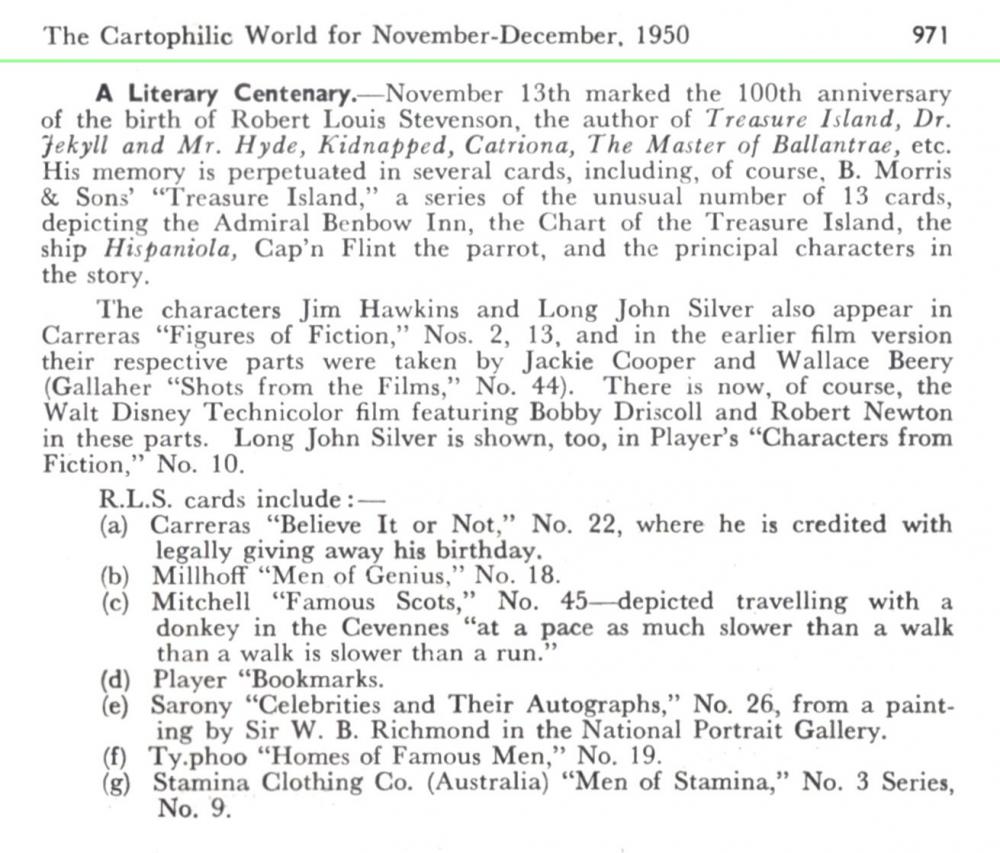
"Treasure Island" started as a magazine serialisation, and was first published as a book by Cassell & Co; strangely this was not on his birthday but on the day after, the 14th of November 1883. Now there were earlier films of "Treasure Island" than mentioned above, the first was in 1912, and in it Jim Hawkins was played by a twenty year old actor called Addison Rothermel. Five years later, in 1917, a second version was made, in which the seven year old Francis Carpenter was cast alongside another child star Virginia Lee Corbin. He seems not to have appeared on cigarette cards, our card is from the Pictures Portrait Gallery of postcards issued through "Pictures" magazine, but the image is a popular one and was also used by Rotary. The costume is from "Jack and the Beanstalk" (1917 - also with Virginia Lee Corbin). Then in 1920, the film was made again, with Shirley Mason playing Jim Hawkins; regular readers of our newsletter will remember that Shirley Mason was Viola Dana`s sister. This version of the film is also notable because Lon Chaney played two of the pirates. Shirley Mason can be found on a set allied to the Pictures Portrait Gallery, dressed as a balllerina, I know not from which film this came, plus on several cigarette cards - four are held as part of the Arents Collection and you can see those at https://digitalcollections.nypl.org/search/index?filters%5Broot-collection%5D=b50ab6f0-c52b-012f-5986-58d385a7bc34&keywords=shirley+mason
I was also struck by the fact Robert Louis Stevenson gave away his birthday! And there is one of the most heart-warming websites you may ever be directed to about this very event at https://uselessinformation.org/annie-louisa-ide-cockran/ By the way the Donkey reference above comes from a book he wrote in 1879; you can read more about this at http://robert-louis-stevenson.org/works/travels-with-a-donkey-in-the-cevennes-1879/ - and it is available to read online, but there are 136 pages. The link is https://freeclassicebooks.com/Robert%20Louis%20Stevenson/Travels%20with%20a%20Donkey%20in%20the%20Cevennes.pdf Something else I like is that in 1889 he went to live in Samoa. He only lived for five more years, but there is something very exciting about that idea.
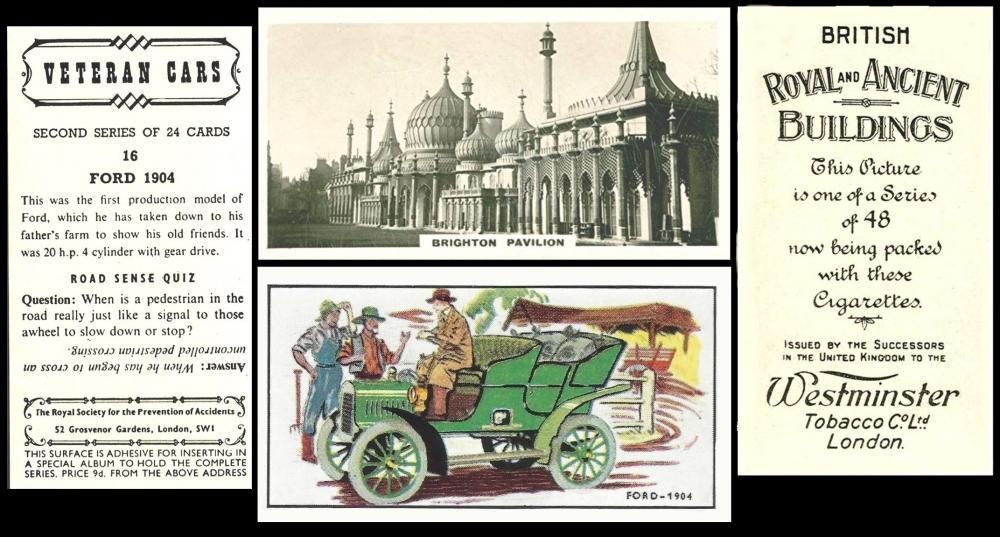
Today, in 1896, was an event that has endured. It was called The Emancipation Run, and in it, thirty-three motorists formed a parade that slowly progressed from London to Brighton, with twenty vehicles being unable to carry on and being left by the wayside. The "Emancipation" was that a new act had been passed, called the Locomotives on Highways Act, and this raised the speed limit for vehicles weighing up to 1.5 tons to a mind blowing 14 mph, two more mph than had previously been allowed. Heavier vehicles were still held back, those of up to two tons being restricted to 8 mph and those over that weight to just 5 mph. The speed limit was eventually raised, to 20 mph, in 1903.
This year, the world’s longest running motoring event, now known as the London to Brighton Run, was the 125th anniversary of that first parade. However it was not the direct descendant of the original, as this version only began in 1927, and it was only for cars built before 1905, so no set of cigarette cards would qualify, the oldest set being Lambert and Butler`s "Motors" first series, issued in 1908. See https://en.wikipedia.org/wiki/London_to_Brighton_Veteran_Car_Run.
and https://www.veterancarrun.com/the-run - where there is even a section of vehicles and parts for sale, plus you can sign up for a regular newsletter. But the burning question is have any of you ever taken part? If so, let us know.
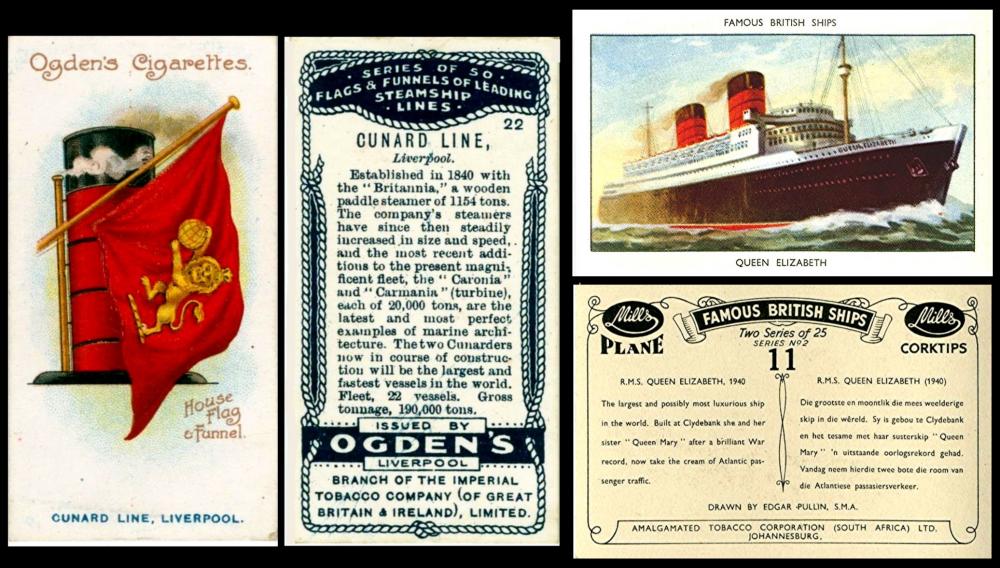
Today in 1968, saw the end of the last Transatlantic voyage for the largest passenger liner in the world, Cunard’s RMS Queen Elizabeth, who docked for the final time in Southampton. Something you may not immediately realise is that she was not named for our present Queen, but for the Queen Mother, wife of George VI and the mother of our present Queen.
This vessel was planned as a luxury liner from the moment her sister ship, the RMS Queen Mary, slid into the water. Nothing was spared in her fixtures and fittings, and she was planned for launch in September 1938. This ceremony did take place, with her namesake performing the ceremony of breaking a bottle of champagne over her bow, though according to those who were there it moved somewhat before the champagne was hurriedly struck to the metal.
In 1938, she featured in Ogden`s "Ocean Greyhounds", a set of fifty cards which show various ocean liners, and includes a card of her being built as well as many sumptuous interiors. This may well have been planned as advance publicity, for the first tickets were due to go on sale for the maiden voyage taking place in April 1940. Unfortunately this trip never happened, for by the time of that trip she had been hastily converted for another usage, and her first passengers were soldiers, as she served in the Second World War as a troopship from February 1940 right until October 1946, after which she returned to the ocean, for the first time in her original costume, as a passenger liner.
Her end was no less dramatic which you can read about and view at https://www.thevintagenews.com/2015/11/24/the-wreck-of-rms-queen-elizabeth-hong-kong-harbor/
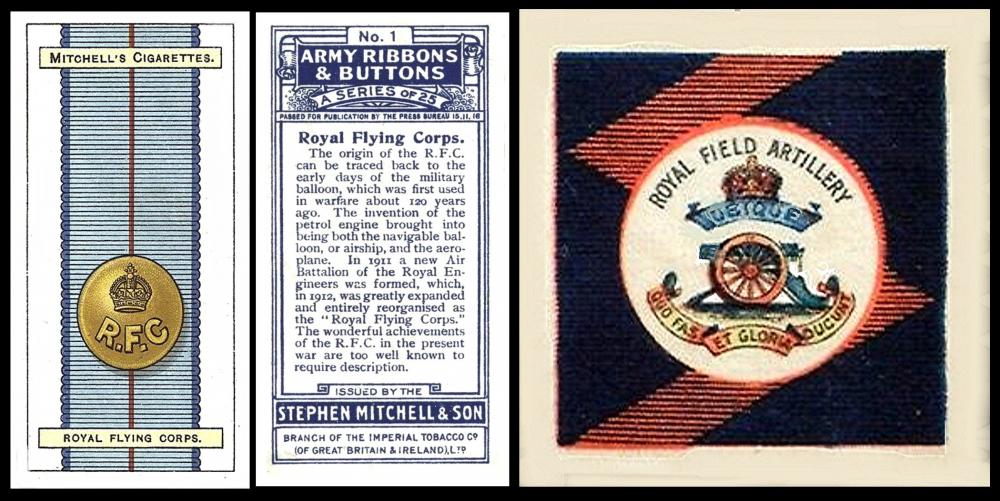
Every 16th of November is National Button Day, and though you probably have never heard of it, it was founded in 1938 by the American "National Button Society" who are still going strong, with a website at https://nationalbuttonsociety.org/
Now you might not think that there is any connection between buttons and cartophily, but think again. Let us start with Stephen Mitchell’s "Army Ribbons & Buttons", issued in 1916; this sought after set of twenty five cards was "passed by the Press Bureau on the 15th of November 1916. The front shows the Regimental ribbon and the button in great detail, whilst the reverse tells the story of each unit including lists of their notable battles. Then we have Carreras "Do You Know" (1939) where card 11/50 tells why men button their coats to the left and ladies to the right, whilst card 46/50 tells the story of why there are buttons on uniforms in the first place, and reveals that buttons were used as badges of rank by the Chinese. Our other "card" is a silk, issued by Happy Home in approximately 1914, I dont have the backing paper though. And hat`s just a start. See how many you can find in your collection!
On 17 November 1976, we grew another branch. For it was on that day that Hants and Dorset Branch first drew breath. We have only just started to research their story but we do know that in 1984 they issued a set of cards of members of their Branch. In 1985, according to the March/April 1985 edition of “Cartophilic Notes and News” (Vol.13, No.130, p.3654) their Secretary was Mr. Roy Wheeler of Wimborne Dorset. They met once a month, on Sunday afternoons at 2.30 pm, at Corfe Mullen Village Hall in Wareham Road. This was located behind the Co-Op, and in 1988 were still meeting there, though they did not meet in August, and the times were 2 and 4.30pm; however the Secretary had become Mr Chris Pozzetti. In 1997, they were one of three co-hosting branches involved with the Cartophilic Convention; the other two being Hants and Surrey, and Winchester and Solent, and all are mentioned on this most attractive Convention Commemorative card showing three ocean liners, a familiar sight in the area, from a wonderful drawing by Paul Merchant. The Branch then moved to St. Pauls Church Hall, where the monthly meetings often included local and national dealers, plus members were encouraged to bring spare cards for swapping or sale. The April 2020 meeting clashed with Easter Sunday so it was moved it to the following week - however world events intervened and that meeting was never held.
Now lets go on a treasure hunt and see what else we can find, and find out, by the anniversary, so come on, join in - glean your memories and search through your collections!
And there were other local branches before this in this area, whose stories we will also tell on that anniversary day!
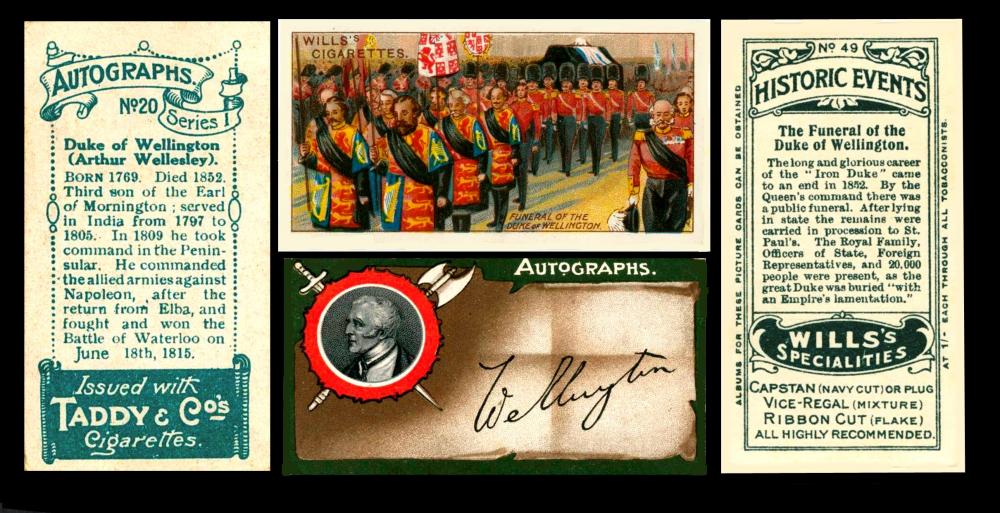
Today in 1852 was the state funeral for Field Marshal the Duke of Wellington K.G. Today he is but a distant figure, but in his living memory he had defeated Napoleon at Waterloo, and was a national hero. He had been born on the first of May 1769, in Dublin, Ireland, and had served as Prime Minister of England twice. You can read more at https://www.gov.uk/government/history/past-prime-ministers/arthur-wellesley-1st-duke-of-wellington
According to https://www.tcdb.com/Person.cfm/pid/85832/col/1/yea/0/Arthur-Wellesley?sTeam=&sCardNum=&sNote=&sSetName=&sBrand= there are twenty-one cards of him. The most unusual is Typhoo "Homes of Famous Men" (1934) 23/24 which shows Apsley House, at Hyde Park Corner, which is now his museum, but at the time of his living there had the wonderful postal address of No.1, London. Though this was his London address, it was not his favourite home, as he much preferred Walmer Castle, in Kent, which he occupied through his office of being the Lords Warden of the Cinque Ports, staying there in the autumn of most years, and being visited by friends and dignitaries. And, fittingly, where he loved was where he died on 14th September, just after 3 p.m., this being and his body remained there until being transported, by train, to the funeral, in St. Paul`s Cathedral, from where it was walked through the streets on a carriage.
The funeral procession towards St Paul`s Cathedral actually appears on a card, W.D. & H.O. Wills "Historic Events" 49/50

Today in 1905, Tommy Dorsey was born. American trombonist, composer and bandleader. They started recording in 1928, mostly for the smaller labels, and moved to Decca in 1934. Their band, the Dorsey Brothers Orchestra, was made up of many people, including Glenn Miller and Francis Albert Sinatra (who would later drop his middle name and shorten Francis to Frank), but it was an increasingly fraught atmosphere and eventually ended when Tommy left the stage during a performance and became part of the Joe Haymes Band which he then renamed to Tommy Dorsey and His Orchestra, setting up in direct competition with his brother. They were brought together during the Second World War and something mellowed, leading to a reunion just in time for "The Fabulous Dorseys", a motion picture in 1947, and to the bands getting back together in 1950. Tommy died in 1956, after which his trombone was placed on stage as a silent tribute. Jimmy died less than a year later.
I would have thought they appeared on cards, but can only find this Picturegoer "W" Series W.101, which is really a commercial issue, sold through the magazine. But they do have another association with cartophily as he and his brother advertised Camels Cigarettes in 1953, one advertisement for which may be seen at https://www.etsy.com/uk/listing/667996746/1953-camel-tommy-jimmy-dorsey-big-band
This week's Cards of the Day...
Well, if you hadnt guessed it by now this week we are joining in with "Movember" and featuring cartophilic moustaches. Their UK website is https://uk.movember.com/ and its not too late to join in with the hirsute happenings and "make a difference" as it lasts all month. And if any of our readers, families, workmates, or pals are already taking part do drop us a line so we can cheer you all on.
It was surprisingly easy to find cards with moustaches, they were much more a fixture in the days of the cigarette card than you might imagine, and many sportsmen sported them. Today, (and very sadly from my point of view) the trend is for our heroes to be clean shaven. Guess I was just born too late....
Saturday, 6th November 2021

Let us start Movember with a fine moustache indeed. And by thanking Mr. Pearks for this scarce card.
This is George Martin LePage, otherwise known as "Dampy". We know that the surname Le Page comes originally from France, and, as you might expect, it does come from a retainer, or page, to a knight or wealthy family. Oddly it is much more common on Guernsey than on Jersey.
On the card, it says that he is the "Wanderers Outside Left [and] an all round athlete, heading the batting averages of two different cricket clubs."
It continues that "Last year he proved himself a good partner to Wheway". Now this was Frank Wheway, and he died of wounds during the First World War in November 1917, just a short time after he had been sent out to war. Before that he had been Captain of the Jersey Wanderers, and, poignantly, their Vice Captain, Joe Whitworth, had been killed in action just a few days earlier.
I have no idea why "Dampy" was so called - if anyone can enlighten us, please do.
By the way he also appears on another set, as card 13 of "Jersey Footballers" by Cigarette Co. Jersey. These appear in our World Tobacco Issues Index as "Grey Background, Second Issue, numbers 1-50" (C86-1.2)
Our World Tobacco Issues Indexes both tell us that the issuer of our card, Simonets, Ltd. were "taken over by Jersey Tobacco Co., 1936." and that their output "includes cards without reference to tobacco". This set is listed there as :
1. Issues 1913-14
LOCAL FOOTBALLERS. Sm. 67-69 x 36. Black and white. Nd. (50).
Their next issue was not until the 1920s, presumably because of the First World War.
There is a checklist of our set at the Football Cartophilic Info Exchange/Simonets
Sunday, 7th November 2021
![W675-092 [tobacco : UK] W.D. & H.O. Wills "Allied Army Leaders" (1917) 16/50](/sites/default/files/styles/content_aligned/public/2021-11/7%20Kitchener%20pair.jpg?itok=FryUSqjU)
These first appeared in our Wills reference book part III (RB14, issued in 1949). They were given the code W/35 and already it was known that there were two printings, but you need to be pretty eagle eyed to spot the difference which is in the I.T.C. Clause. One set, presumably the first as it given the A classification, has it ending "& Ireland), Ltd." whilst B ends "& Ireland) Ltd."
If you still haven't spotted it, there is a comma after the bracket.
I am fairly certain this error was first spotted by Colonel Bagnall, as it appears in his LCCC Catalogue for 1950. From the pricing it appears that the one without the comma was scarcer, as this was 1/6d. to 4/6d. a card, compared to the comma version which was only 7d. to 1/3d. a card. Interestingly it says "With comma (or stop)", so the tail cannot have been very receptive to the ink during the production... The sets were listed only at the top, not tied to a printing. This probably meant that whichever set was in stock would be supplied unless a preference was made. These sets were 70/-.
Another barely noticeable error is in the style of the date the set was "passed by the Press Bureau" for it can be found as either 30.11.16 or 30-11-16; it was quickly realised that cards with and without commas could be found with either date style.
There is also a reference to slight alterations in the text and to changes in the rank of the subject, which I have not done a study of, but wonder if anyone out there has? And whether you would like to share your findings on our site ?
Horatio Herbert Kitchener died in June 1916, whilst these cards were being prepared, so his name appears on the front as “LATE F.-M EARL KITCHENER” The “F.-M” is Field Marshal. On the back it adds “K.G.” for Knight of the Garter. His death, quoted as being “Drowned while on his way to Russia, June 1916”, is now the subject of much speculation, most now not believing it was not an accident that his ship was lost at sea. You can see the wreck and read more, via https://www.dailymail.co.uk/news/article-3654119/The-underwater-grave-Lord-Kitchener-736-men-died-warship-hit-100-years-ago.html - whilst other interesting sites include https://www.liquisearch.com/herbert_kitchener_1st_earl_kitchener/death/conspiracy_theories - and - https://anilbalan.com/2013/10/06/the-curious-case-of-lord-kitchener/
Monday, 8th November 2021
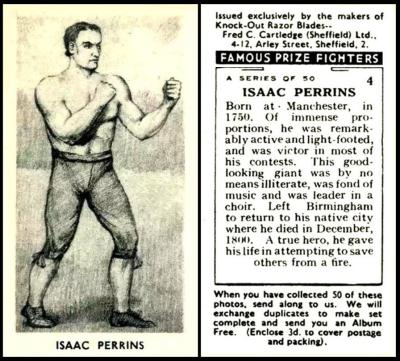
As part of our movember tribute, we must mention King Camp Gillette, born on January 5th, 1855. Though, contrary to popular knowledge he was not actually the inventor of the safety razor, he merely invented a better version than the ones currently being used which used a thin, disposable blade. He died on July 9, 1932. You can read more about him at Britannica.com/KCG. And yes, his name still lives on with "Gillette" razors - in fact one of their latest brands is named after him, as The King C. Gillette brand
Six years after his death, along came our card. And in case you are puzzled over the connection between a razor and a set of boxing cards, it was because their razor was called "The Knock-Out" - and the packaging featured a boxing image on both the box and the sleeves in which the blades came.
The set is very well done, though only monochrome, which some may find disappointing. It does feature some very well known pugilists though, modern ones like Jack Dempsey , Joe Louis, and Max Schmeling - and some from the dawn of the sport like James Corbett, Tom Spring and Bill Neat. There is also a mix of art drawn cards (the early images) and photographs (the more modern ones) - perhaps that is the reason why the monochrome was chosen.
There is one curious anomaly, as only one of the cards, the Frenchman Gustave Humery, No.44, is horizontal in format, all the rest are vertical. Yet if you look at his online biographies there are pictures of him standing up. So why did the makers not search a little harder for one that matched the rest?
As for our man, Isaac Perrins, it is quite a sad story. He seems to have been a gentle giant of a man, who worked for Boulton and Watt, the steam engine makers at the same time he was a bareknuckle boxer. His father had also worked there. After retiring from boxing he ran a public house, and in 1799 became the lead man of the Manchester Fire Brigade. Just over twelve months later, he was involved in the attempt to fight a huge warehouse fire that burned, unstoppable, all through the night of the 10th of December 1800, and on the 29th of that month he was awarded £20 a year for his efforts, but it is doubtful he ever recieved a payment, as he died on January 6th, 1801, aged just fifty, he died, as a direct result of exertion, and fever, both caused through the fire. There is a sad subtext to this, as his beloved wife had died just a few months earlier, and there is a strong suspicion that perhaps he took those extra efforts so that they not be parted long.
The set is first catalogued in our original British Trade Index, with an informative header, as :
F. C. CARTLEDGE, Hornsea and Sheffield.
Cards issued 1938-42. Includes cards inscribed "Knock-Out" Razor Blades, without name of firm.
Two sets are listed, Epigrams, and ours, which is listed as :
FAMOUS PRIZE FIGHTERS. Sm. 66 x 36. Black. Nd. (50), two subjects at No.13 (Eric Boon and William Thompson) and 19 (Arthur Danahar and Bill Doherty) ...CCL-2
There is another discovery reported in our original British Trade Index part III, namely
CCL-2 (Famous Prize Fighters). Fronts are found matt or glazed to cream shade.
When our four original Trade Indexes were updated into one volume, for the year 2000, the text had tidied quite a bit. It now reads :
Fred C. CARTLEDGE (Sheffield) Ltd,. Hull, Hornsea and Sheffield
Issued 1938-42. Includes brand issues "Knock-Out" Razor Blades and Rheuma SaltsFAMOUS PRIZE FIGHTERS. 1938. 66 x 36. Black. Nd. (50). Fronts (a) matt (b) glazed. Two subjects at No. 13 (a) Eric Boon (b)William Thompson) and No.19 (a) Arthur Danahar (b) Bill Doherty. Album issued ...CAR-540
Tuesday, 9th November 2021
![T045-400 [tobacco : UK] James Taddy & Co. "Royalty Series" (1903) 8/25](/sites/default/files/styles/content_aligned/public/2021-11/9%20taddy.jpg?itok=RDTaeVzm)
This may be a terribly tatty Taddy but it just happens to be the only Taddy Card I own. It came to me in a mixed lot and I never had the heart to part with it.
Taddy isued three groups of Royalty cards, but this is the first we will deal with. It is a set of twenty-five cards, which were actually entitled ”Royalty Series” - this is stated to have been issued with “Backs in Myrtle Green, with advertisement for “Myrtle Grove” Tobacco.
Now I thought that was a bit odd, because I was sure my back was blue, and indeed it is, but not only is it not green, it is entirely different, having the advert for variously sized tins of “Premier Navy Cut [Tobacco], Mild Medium and Full Strengths”.
In addition there is no illustration of this back within our original Taddy reference book (RB12, issued in 1948). There is an illustration of a “Premier Navy Cut” back which accompanies “Natives of the World”, but it it much more modern in style, or it could be the back that is quoted for “Boer Leaders” which states “Taddy`s Premier Navy Cut” but does not describe further so might be the same as the one which is shown. Are there any Taddy experts who can clarify this?
There were also two smaller groups, the first being a small five card set(?) which was untitled and un-numbered, and early researchers gave that the name of English Royalty, the cards show Queen Victoria and the two generations below her, these being King Edward VII and King George V, plus their Queens – whilst the second is usually considered as part of a mixed lot known as “Royalty, Actresses, Soldiers” which are again un-numbered and untitled. The Royalty cards in that lot were the Emperors and Empresses of Austria and Germany, the King and Queen of Italy, the Czar and Czarina of Russia, and our own Prince and Princess of Wales. This seems to cover European Royalty, so I tend to lean towards the original theory, that this was a set all its own of ten cards, perhaps with that name, and that the Actresses and Soldiers were also supposed to be alone as separate sets.
I seriously think we need a Taddy specialist to get in touch!
Wednesday, 10th November 2021

Again this was simply picked for being a man with a movember moustache, but I did like his smile, and think the Tatler got it right.
He turned out to be Thomas Kirkby "Tom" Walls, not just “a stage and screen star, producer, hunting and racing man”, but to have been “winner of the Derby in 1932” with a horse called April the Fifth who appears on John Player "Derby and Grand National Winners" 25/50. He also worked in a locomotive works, was a jockey, formed part of a seaside Pierrot troupe, was manager of the Shaftesbury Theatre from 1922 and was the assembler of the Aldwych Farces in the 1920s, may of which were remade as films in the following decade.
And sixteen cards of him are listed at the Trading Card Database/TomWalls
Our set is first listed in our original Gallaher Reference Book (RB.4, issued in 1944) as :
1936. 48. SPORTING PERSONALITIES (titled series). Size 2 1/2" x 1 7/16". Numbered 1-48. Fronts printed in full colour by offset-litho, black frame lines, white margins and subjects titled. Backs printed in sage green with descriptions and "Issued by Gallaher Ltd. Virginia House, London & Belfast" in block letters. Printed by E. S. & A. Robinson Ltd., Bristol.
There are no card codes in that volume.
In our World Tobacco Issues Indexes, the description is shortened to simply :
SPORTING PERSONALITIES. Sm. Nd. (48)
Thursday, 11th November 2021
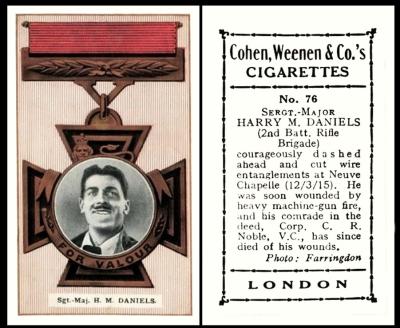
Today, on our first Armistice Day at our new website, we are going to start an annual routine and pick a military portrait, at random, then see how much we can discover about the person portrayed.
This is a very unusual and striking card, where the portrait is actually inset within a Victoria Cross medal - first awarded in June 1857. On the back of the card it tells us that the portrait is of Sergeant Major Harry M Daniels (2nd Battalion Rifle Brigade) and that the medal was won because he "courageously dashed ahead and cut wire entanglements at Neuve Chapelle (12/3/15). He was soon wounded by heavy machine-gun fire and his comrade in the deed, Corp. C. R. Noble, V.C., has since died of his wounds. Photo Farringdon."
It seems likely that this has been taken from the citation, which was printed in the newspapers, which reads "For most conspicuous bravery on 12th March, 1915, at Neuve Chapelle. When their battalion was impeded in the advance to the attack by wire entanglements, and subjected to a very severe machine-gun fire, these two men voluntarily rushed in front and succeeded in cutting the wires. They were both wounded at once, and Corporal Noble has since died of his wounds."
Harry M. Daniels was born in Norwich, Norfolk, on December 13, 1884 - and he is often said to be the first person from that county to win the Victoria Cross. This is not true, that honour goes to Henry Ward, born at Harleston, who was born in 1823 and was dead almost twenty years before our man breathed his first. He won his Victoria Cross during the Indian Mutiny, at the end of September 1857, just three months after its debut. And just over five hundred of them would be awarded up to the start of the First World War - a total only beaten by the six hundred and twenty eight which were awarded during it. After that the amount given out dwindles, and only just over two hundred have been awarded in the years between 1918 and the present day.
However, unless I find otherwise, it looks like our man was the first Norfolk man to be awarded the V.C. during the First World War, though this was only presented to him on 15 May 1915. But this is almost certainly where the confusion comes in.
Sadly our man had a difficult childhood, which saw him and his siblings orphaned and split up, he ran away to sea. His brother found a different adventure, and he joined the army, serving with the Coldstream Guards in the Boer War, where he was killed. As soon as our man was old enough, he also joined the army, but in the Rifle Brigade. He found himself in India, where his bravery and independence saw him rise swiftly through the ranks, and he seems to have done much the same during the First World War.
There is one very strange thing, for he was reported killed in action in September 1915, much to the sadness of his wife, to whom he had been wed less than a year. However this proved not to be true. It would not affect his bravery either and he would later be awarded the Military Cross as well.
This is an odd set, which is often called "V.C. Heroes" but is actually part of a larger set which is untitled, though has been given the adopted title of "War Series - World War I". This is described in our original World Tobacco Issues Index as :
WAR SERIES - WORLD WAR I (A). Sm. 63 x 37-38 ... C102-42
1. Admirals, Warships and Leaders. Nd. 1/50. See H.103
2. V.C. Heroes. Nd. 51-100
Friday, 12th November 2021
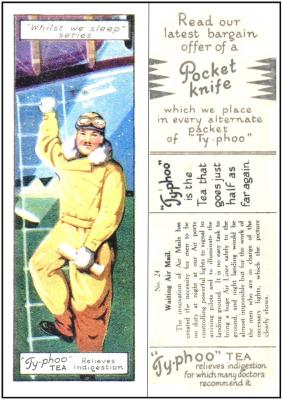
Many of these workers would find themselves and their jobs well and truly caught up in The Second World War in less than ten years, with this air mail pilot and his trusty aeroplane both almost certainly being swept off into the RAF, though perhaps he might have found himself part of the Army Postal Services, which was pretty much run by the Royal Engineers (Postal Section).
I think the way the cards are drawn definitely foretells the change in the air with its shadows, and its dark backgrounds, and its use of torchlight illumination.
We will never know who these men were modelled on, because nobody thought those sort of facts worth recording, and the same is true for most cards of non-celebrities, which is a very great shame.
This is a most attractive set, and you can see all of the cards at https://buttes-chaumont.blogspot.com/2013/12/whilst-we-sleep-with-typhoo-tea.html
If you have pinterest you can also see them at https://www.pinterest.co.uk/gene1897/whilst-we-sleep-typhoo-tea-cards/ but I can only look so far before they block me for not having an account.
Typhoo Tea is still going, dare I say it, "strong" (or is that just the way I make it?) and it has a website, not just to sell its wares, though this is of course the primary purpose of most websites. It also includes the story of how the business came to exist, at https://typhoo.co.uk/about-us/great-british-tea-since-1903/ - during which it even mentions that from 1906 John Sumner included "circulars .... and picture cards ... inside the packets. These are still collectable to this day!"
And now, before I fall asleep and dont suddenly awake with a jerk and think aargh newsletter, adieu! Hope you enjoyed it, and lets hope next week is easier! Until then, pleasant dreams, happy finds, and good companions to you all
for new readers, and anyone who wishes to re-read it, our last week`s newsletter is still visible at https://csgb.co.uk/publications/newsletter/2021-11-06
